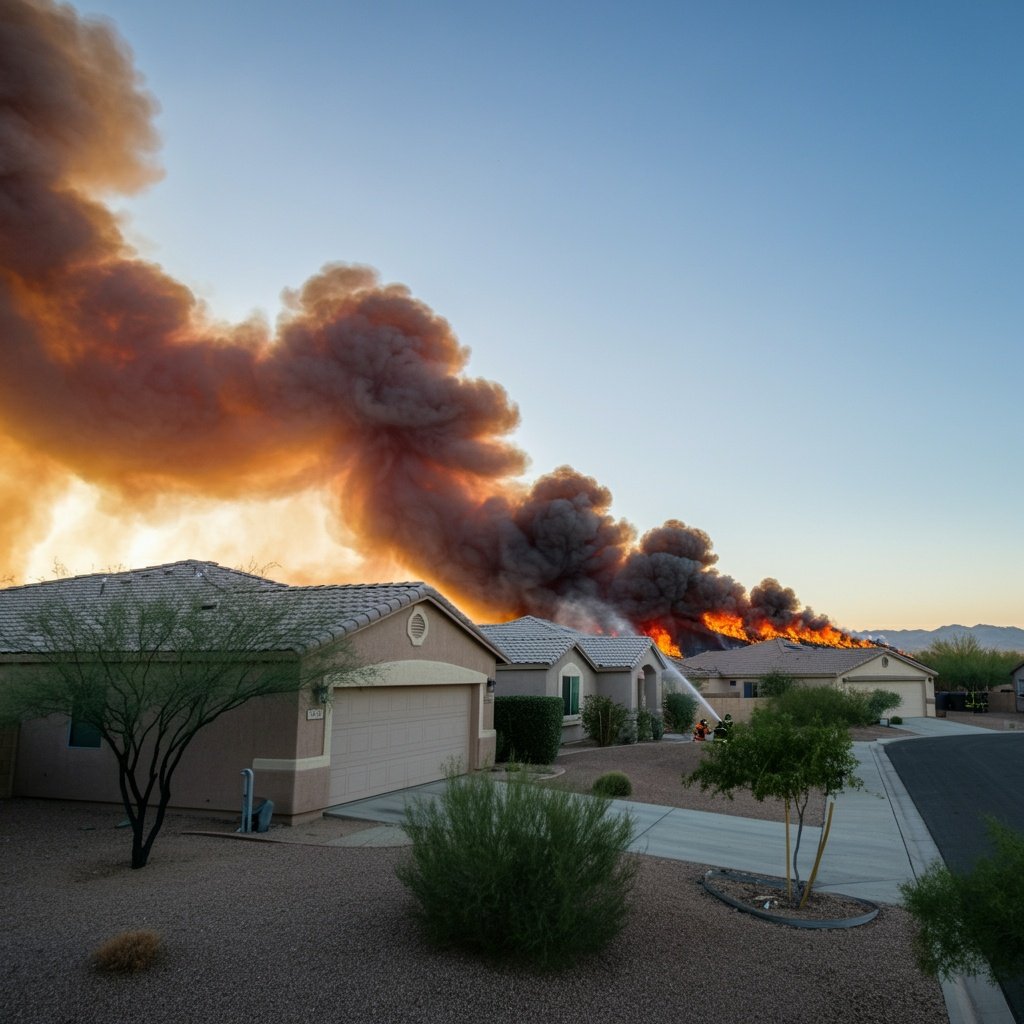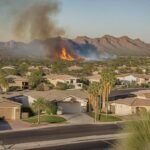Will California Fires Spread To Arizona?

CA Wildfires cannot spread to Arizona- BUT
Housing fire risks are a pressing concern for homeowners across the southwestern United States, particularly in Arizona and Southern California. Both regions share arid climates, seasonal winds, and proximity to fire-prone landscapes, yet they experience housing fires under distinct circumstances due to environmental, demographic, and regulatory differences. Understanding these distinctions sheds light on the unique challenges and mitigation strategies needed in each area.
——————-
Get a free insurance coverage analysis by an insurance professional, courtesy of Better Quotez. There will be no attempts to sell you anything.
——————-
Environmental Factors
Arizona and Southern California are both characterized by dry conditions, but their fire risks arise from different environmental factors. In Arizona, the desert climate combines with monsoon seasons, which can lead to lightning strikes igniting wildfires. The state also experiences prolonged droughts that leave vegetation dry and highly flammable. Housing developments in rural or suburban areas near deserts and forests are particularly vulnerable.
Southern California, by contrast, faces a unique threat from the Santa Ana winds, which can intensify wildfires and spread embers over vast distances. The region’s Mediterranean climate supports chaparral ecosystems that are highly combustible during dry summer months. Additionally, urban-wildland interface areas—where housing developments meet natural landscapes—are more extensive in Southern California than in Arizona, leading to a higher risk of catastrophic fires affecting homes.
Demographics and Urbanization
The scale of urbanization plays a significant role in fire risks. Southern California is home to densely populated cities like Los Angeles and San Diego, where housing developments often encroach on fire-prone areas. High-density housing and older infrastructure in these regions increase the potential for fires to spread rapidly within neighborhoods. In contrast, Arizona’s housing developments are generally more spread out, reducing the likelihood of fire spreading from one home to another. However, this dispersion often places homes closer to open landscapes, increasing their exposure to wildfires.
Historical Incidents
Southern California has a long history of devastating fires that have destroyed entire neighborhoods. Notable examples include the 2018 Woolsey Fire, which burned nearly 97,000 acres and destroyed over 1,600 structures, and the 2003 Cedar Fire, which consumed 2,820 buildings. These fires highlight the scale of destruction that can occur when wildfires intersect with densely populated areas.
Arizona has also experienced significant fires, though they tend to affect fewer structures. Fires like the 2021 Spur Fire in Bagdad and the 2022 Tunnel Fire near Flagstaff illustrate the risks to housing in the state. However, these incidents have generally involved smaller numbers of homes compared to the catastrophic losses seen in Southern California.
Regulatory and Mitigation Efforts
California has implemented stringent building codes and defensible space requirements to mitigate housing fire risks. Regulations mandate fire-resistant materials for new constructions and require homeowners to maintain clear vegetation around their properties. Arizona, while adopting similar measures in some areas, has less comprehensive statewide regulations. Efforts in Arizona often rely on community-level initiatives and voluntary compliance, which can vary widely.
Arizona Specific Actions
In Arizona, several communities have proactively adopted regulations and initiatives to mitigate housing fire risks, particularly in areas prone to wildfires. These measures often involve implementing building codes, creating defensible spaces, and participating in programs like Firewise USA™
The Arizona Department of Forestry and Fire Management (DFFM) plays a pivotal role in fire prevention across the state. The Office of the State Fire Marshal, operating under Title 37, Chapter 9, Article 4 of the Arizona Revised Statutes, is tasked with promoting public health and safety by reducing fire hazards. This includes adopting fire protection codes and conducting inspections to ensure compliance.
Community Wildfire Protection Plans (CWPPs)
Many Arizona communities have developed Community Wildfire Protection Plans (CWPPs) to address local wildfire risks. These plans are collaboratively developed by local and state government representatives, in consultation with federal agencies and other interested parties. An approved CWPP can influence and prioritize future funding for hazardous fuel reduction projects, including where and how federal agencies implement fuel reduction projects on federal lands.
Firewise USA™ Recognized Communities
Participation in the Firewise USA™ program is another significant step communities take to mitigate housing fire risks. This program educates homeowners on actions to protect their homes and communities from wildfires. As of 2023, Arizona has 154 Firewise USA™ recognized communities, with 30 new communities added that year. These communities span various counties, including Coconino, Gila, Maricopa, Navajo, Pima, Pinal, and Yavapai.
Local Regulations and Building Codes
Some municipalities have implemented specific building codes and regulations to enhance fire safety. For instance, the City of Scottsdale has adopted amendments to the International Fire Code, including requirements for automatic fire sprinkler systems in certain residential structures.
Community Initiatives
Beyond formal regulations, communities engage in various initiatives to reduce fire risks. These include organizing local Firewise committees, conducting fuel reduction projects, and educating residents about creating defensible spaces around their properties. Such grassroots efforts are crucial in areas where formal regulations may be limited.


